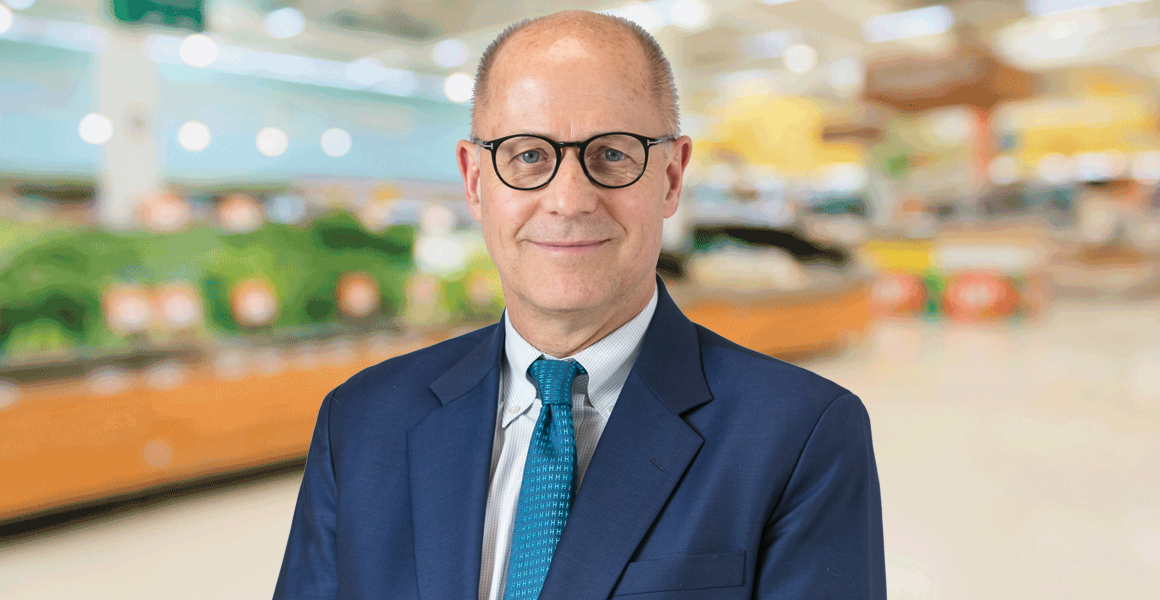The end of 2019 will mark the beginning of the end for PayPoint’s yellow terminal. The move represents the company’s desire to become the tech centre of every store, around its PayPoint One EPoS. CEO Dominic Taylor explains how the change reflects trends in the wider convenience sector
Company CV
Company PayPoint
Chief executive Dominic Taylor
Profile Former Royal Navy officer and Vodafone director Dominic Taylor joined PayPoint in 1997 and rapidly progressed from retail director to chief executive.
Latest news Customers indebted to struggling rent-to-own retailer BrightHouse can now make payments through PayPoint stores following a deal between the two firms.
RN How will independent retailers fare in the ever-changing convenience model?
DT Change in convenience has been dramatic and presents a challenge for everyone, whether
it’s shopkeepers, producers or the supply chain. The model is adapting and we all have roles to play.
Consumers are buying more online and the high street is in decline because of that. But I believe one thing that is certain to remain is the local shop. Whether it will look like a local shop today is a subject of debate, but it’s important to remember that it is able to do everything the online shop cannot.
This is both frightening and exciting for retailers, but PayPoint is uniquely positioned to build
a system that works for retailers and can cater for this change. We see ourselves being a key stakeholder with a real desire to make a difference and enable retailers to achieve.
RN Do you believe PayPoint’s agreements with challenger payment brands help offset mobile and utility transaction decline?
DT I do, but this is always difficult to predict. It depends on companies like us working hard to make those services available and the desire of retailers to get behind them. We’re bringing in things like Monzo and digital banking. Elsewhere, we’re trying more experimental ideas to give customers more reasons to visit local shops, such as a trial with Link, which offers over-the-counter cash and pays the retailer a fee for the deployment of cash.
We are simply trying to facilitate a better consumer solution to provide continued access to cash through a lower-cost mechanism, but some retailers will gravitate towards this and others not so much. However, I hope all of them do.
RN Do you see the UK convenience market following the US and others that focus heavily on gift cards?
DT The UK market is different to the US in that its prepaid cards are a lot more prevalent in the UK. US gift card companies have chucked tons of money at the multiples, trying to get it to take off, which the multiples were more than happy to take, but it hasn’t achieved what they were expecting.
Where we do see changing gift card behaviour is in e-money things like Amazon Cash and gaming vouchers. It is very spiky and sales are closely linked to game releases and purchasing. For instance, Boxing Day saw a large increase.
RN There are now more than 12,000 stores using PayPoint One. Do you believe it will be more challenging to covert the remaining users?
DT We have been really pleased with the roll-out so far, but the honest answer is I don’t know. I am an eternal optimist by nature and I’d like to think that the way we are evolving the service and communicating the benefits retailers can receive will make the tail end relatively small.
RN The parcel market is competitive and PayPoint’s parcel volumes declined in 2018. What is your strategy in taking back market share from your rivals, such as myHermes?
DT We don’t see ourselves as being in competition with myHermes. We’re open to all carriers now
and we want to sign them up to deliver more volume to retailers. As we start to build partnerships,
we can start to offer something more competitive.
It’s not about us being separate. Why doesn’t myHermes submit an application to use our terminal? They could then deliver parcels to our stores, too. You would expect us to be talking to other carriers and we have been, but it’s just a question of time before we pick up more partners. Some carriers are very progressive and others aren’t. One of our main challenges as a business is that we had a joint venture where we married one carrier and the industry is aware of that.
All I care about is trying to aggregate these types of services for local shops. I see this as an opportunity to provide – we have already got the kit there, so let’s clean up the counter and share carriers.






Comments
This article doesn't have any comments yet, be the first!